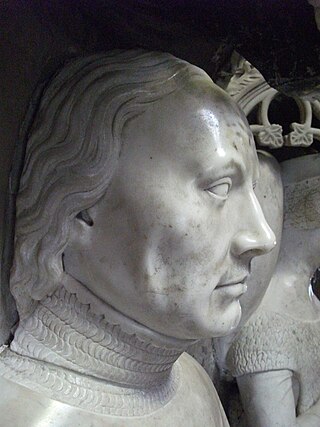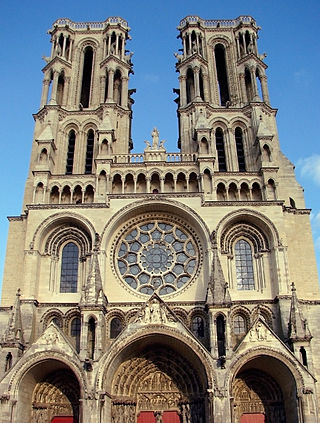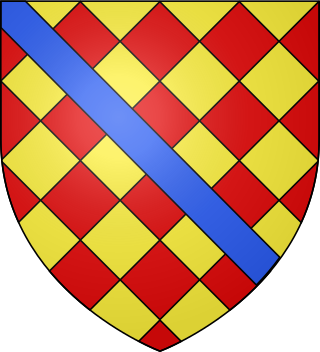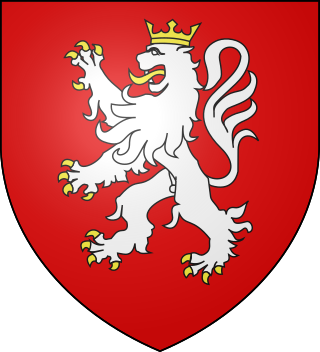Related Research Articles

Philip II the Bold was Duke of Burgundy and jure uxoris Count of Flanders, Artois and Burgundy. He was the fourth and youngest son of King John II of France and Bonne of Luxembourg.

Charles VI, nicknamed the Beloved and in the 19th century, the Mad, was King of France from 1380 until his death in 1422. He is known for his mental illness and psychotic episodes that plagued him throughout his life.

Olivier V de Clisson, nicknamed "The Butcher", was a Breton soldier, the son of Olivier IV de Clisson. His father had been put to death by the French in 1343 on the suspicion of having willingly given up the city of Vannes to the English.

The Collège de Montaigu was one of the constituent colleges of the Faculty of Arts of the University of Paris.
Gilles II Aycelin de Montaigu or Montaigut, Montagu, was a French religious and diplomat who became Lord Chancellor of France, Cardinal from 1361 and bishop of Frascati from 1368. He was the chief negotiator for Jean II of France with the English, in the aftermath of the battle of Poitiers. Towards the end of his life he lived in Avignon on a livery from Cambrai. He died in there on 5 December 1378.

The diocese of Laon in the present-day département of Aisne, was a Catholic diocese for around 1300 years, up to the French Revolution. Its seat was in Laon, France, with Laon Cathedral. From early in the 13th century, the bishop of Laon was a Pair de France, among the elite.

Pierre de Craon, known as "le Grand", was a medieval French aristocrat notorious for his riotous temperament, culminating in his attempted murder of Olivier V de Clisson, Constable of France. Events following the assault led to the mental breakdown of King Charles VI of France and ushered in a long period of political instability in France.
Étienne de La Grange was a French politician of the group of counselors of kings Charles V and Charles VI designated as the Marmousets by their detractors. He was the brother of Cardinal Jean de La Grange. Knighted in 1371, he was elected president of the parliament in 1373, where he was a consultant from 1369.
Jean Le Mercier, who died 3 July 1397, Lord of Nouvion, was a French politician, advisor to kings Charles V and Charles VI. He was appointed by his detractors as being one the Marmousets. He was also Grand Master of France.
Bureau de La Rivière was a French politician, knight and royal adviser. He was the chamberlain of Charles V the Wise and an advisor to Charles VI the Beloved. Like Bertrand du Guesclin and Louis de Sancerre, he was buried in the Basilica of St Denis at the feet of the king he had loyally served.
Nicolas du Bosc, or du Bois, was a French politician, advisor to kings Charles V and Charles VI of France. He was one of the marmousets appointed by his detractors who took the governing of France from November 1392.
Guillaume IV de Melun, Count of Tancarville, Lord of Montreuil-Bellay, was a French politician, chamberlain and advisor to King Charles VI of France. He was one of the marmousets who governed France between 1388 and 1392.

Pierre Aycelin de Montaigut or Montaigu, Montagu, known as Cardinal de Laon, born between 1320 and 1325 and died 8 November 1388, was a fourteenth-century French cardinal, who was the bishop of Nevers (1361–1371) and bishop of the Diocese of Laon (1371-1386), advisor to the king of Charles V and peer of France.

Gilles I Aycelin de Montaigu or Montaigut, was a French Archbishop and diplomat who became Lord Chancellor of France.

Jeanne de Clisson (1300–1359), also known as Jeanne de Belleville and the Lioness of Brittany, was a French/Breton noblewoman who became a privateer to avenge her husband after he was executed for treason by King Philip VI of France. She crossed the English Channel targeting French ships and often slaughtering their crew. It was her practice to leave at least one sailor alive to carry her message of vengeance.

The sieges of Vannes of 1342 were a series of four sieges of the town of Vannes that occurred throughout 1342. Two rival claimants to the Duchy of Brittany, John of Montfort and Charles of Blois, competed for Vannes throughout this civil war from 1341 to 1365. The successive sieges ruined Vannes and its surrounding countryside. Vannes was eventually sold off in a truce between England and France, signed in January 1343 in Malestroit. Saved by an appeal of Pope Clement VI, Vannes remained in the hands of its own rulers, but ultimately resided under English control from September 1343 till the end of the war in 1365.
Jean Harpedenne II was a French aristocrat, administrator and military officer. He was the seigneur of Belleville and a Marmouset at the court of King Charles VI.

Olivier IV de Clisson (1300–1343), was a Breton Marche Lord and knight who became embroiled in the intrigue of Vannes and was subsequently executed by the King of France for perceived treason. He was the husband of Jeanne de Clisson who eventually became known as the Lioness of Brittany.

Olivier II de Clisson, the Younger, was a Breton frontier lord and son of Olivier I, the Elder of Clisson.

Jean II de Montmorency, held the office of Grand Chamberlain of France. He was the eldest son of Jacques de Montmorency and Lady Philippine de Melun of Croisilles and Courrières, daughter of Hugues de Melun d'Epinoy.
References
- ↑ Kibler, William W. (1995). Medieval France: An Encyclopedia of the Middle Ages. Routledge. p. 91. ISBN 978-0824044442.
- 1 2 Wagner, John A. (2006). Encyclopedia of the Hundred Years War. Greenwood Press. p. 212. ISBN 0-313-32736-X.
- 1 2 Knecht, Robert (2007). Valois: Kings of France 1328-1589. Hambledon Continuum. p. 48. ISBN 978-1-85285-522-2.